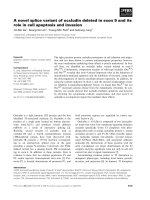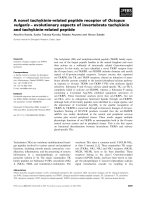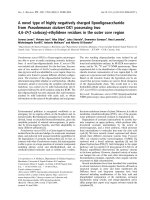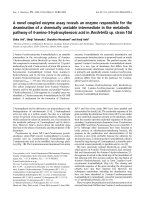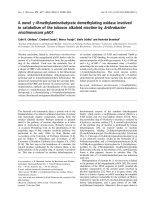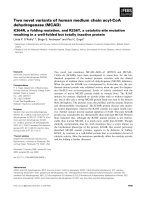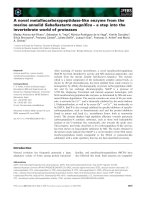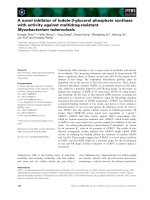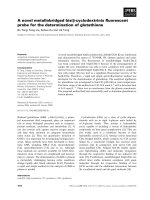Báo cáo khoa học: A novel mechanism of V-type zinc inhibition of glutamate dehydrogenase results from disruption of subunit interactions necessary for efficient catalysis doc
Bạn đang xem bản rút gọn của tài liệu. Xem và tải ngay bản đầy đủ của tài liệu tại đây (618.05 KB, 12 trang )
A novel mechanism of V-type zinc inhibition of glutamate
dehydrogenase results from disruption of subunit
interactions necessary for efficient catalysis
Jaclyn Bailey
1
, Lakeila Powell
2
, Leander Sinanan
3
, Jacob Neal
3
, Ming Li
4
, Thomas Smith
4
and Ellis Bell
3
1 Gustavus Adolphus College, St Peter, MN, USA
2 Virginia State University, Petersburg, VA, USA
3 Department of Chemistry, University of Richmond, VA, USA
4 Donald Danforth Plant Science Center, St Louis, MO, USA
Keywords
allostery; glutamate dehydrogenase; protein
dynamics; subunit interactions; zinc
inhibition
Correspondence
E. Bell, Department of Chemistry, University
of Richmond, Richmond, VA 23173, USA
Fax: +1 804 287 1897
Tel: +1 804 289 8244
E-mail:
(Received 9 March 2011, revised 13 June
2011, accepted 7 July 2011)
doi:10.1111/j.1742-4658.2011.08240.x
Bovine glutamate dehydrogenase is potently inhibited by zinc and the major
impact is on V
max
suggesting a V-type effect on catalysis or product release.
Zinc inhibition decreases as glutamate concentrations decrease suggesting a
role for subunit interactions. With the monocarboxylic amino acid norva-
line, which gives no evidence of subunit interactions, zinc does not inhibit.
Zinc significantly decreases the size of the pre-steady state burst in the reac-
tion but does not affect NADPH binding in the enzyme–NADPH–gluta-
mate complex that governs the steady state turnover, again suggesting that
zinc disrupts subunit interactions required for catalytic competence. While
differential scanning calorimetry suggests zinc binds and induces a slightly
conformationally more rigid state of the protein, limited proteolysis indi-
cates that regions in the vicinity of the antennae regions and the trimer–tri-
mer interface become more flexible. The structures of glutamate
dehydrogenase bound with zinc and europium show that zinc binds between
the three dimers of subunits in the hexamer, a region shown to bind novel
inhibitors that block catalytic turnover, which is consistent with the above
findings. In contrast, europium binds to the base of the antenna region and
appears to abrogate the inhibitory effect of zinc. Structures of various states
of the enzyme have shown that both regions are heavily involved in the con-
formational changes associated with catalytic turnover. These results sug-
gest that the V-type inhibition produced with glutamate as the substrate
results from disruption of subunit interactions necessary for efficient cataly-
sis rather than by a direct effect on the active site conformation.
Structured digital abstract
•
GHD binds to GHD by x-ray crystallography (View interaction)
Introduction
Bovine liver glutamate dehydrogenase (GDH) (EC
1.4.1.3) catalyzes the oxidative deamination of L-gluta-
mate and various monocarboxylic acid substrates [1].
The enzyme also shows the unique ability, among
mammalian dehydrogenases, of being able to utilize
either NAD
+
or NADP
+
as cofactor in the reaction
Abbreviation
GDH, glutamate dehydrogenase.
3140 FEBS Journal 278 (2011) 3140–3151 ª 2011 The Authors Journal compilation ª 2011 FEBS
with near equal affinity, although NAD(H) has an
additional binding site per subunit [2]. The enzyme,
which is a hexamer of chemically identical polypeptide
chains [3,4], exhibits negative cooperativity [5,6] result-
ing from coenzyme-induced conformational changes
[7–9]. More recent work has shown that this coen-
zyme-induced conformational change requires a dicar-
boxylic acid substrate or analog with a 2-position
substituent [10]. A variety of previous studies have
shown the importance of two appropriately positioned
carboxyl groups for strong interaction of substrates or
analogs with the enzyme [11–13] and for synergistic
binding of substrate (or analog) with either oxidized
[14,15] or reduced [2] cofactor. With alternative amino
acid substrates such as norvaline, the manifestations of
cooperative interactions between the subunits of the
enzyme are absent [5,16]. Since it has been shown that
the entire hexamer is required to give optimal activity
of the enzyme [17] with glutamate as substrate, it is
likely that the cooperative interactions between subun-
its in the hexamer are required for maximal activity.
Our recent work has shown the importance of confor-
mational flexibility [18] and the strength of subunit
interactions [19] in glutamate promoted cooperativity
that is absent with norvaline. This is consistent with
the fact that the overall rate of oxidative deamination
is very much lower with alternative amino acid sub-
strates.
GDH from mammalian sources is highly regulated
by a diverse array of small molecules, with ADP,
GTP, leucine and the combination of malate and pal-
mitoyl CoA being the most effective regulators of the
activity [20–22]. The enzyme was originally considered
to be a zinc metalloenzyme [23]; however, subsequent
work [24] showed that the enzyme demonstrates full
activity in the absence of any bound zinc and that
zinc is in fact a potent inhibitor of the enzyme. Our
own more recent studies [25] showed that the triva-
lent europium ion could displace zinc from the
enzyme and relieve the zinc-induced inhibition. Like
the allosteric inhibitor GTP, zinc induces the presence
of a second, inhibitory NADH site on the enzyme
which, unlike the active site, shows a considerable
preference for NAD(H) over NADP(H) [2].The physi-
ological importance of possible zinc inhibition of
GDH is not clear, although zinc poisoning [26] shares
some similar symptoms to Reye’s syndrome which
has previously been shown to involve alterations in
the regulation of GDH [27], and elevated zinc levels
have been associated with neurological disease [28].
Under normal circumstances in vivo zinc concentra-
tions have been estimated to be in the range
25–100 l
M [29].
Although the crystal structure of both bovine and
human forms of the enzyme are now available [30–32]
and have led to considerable insight into the structural
basis for subunit interactions in this enzyme and
the mechanism of regulation by purine nucleotides, the
structures have not revealed either the nature of the
zinc binding site or the basis for zinc inhibition.
In the current study, in addition to further defining
the nature of the interaction of zinc with GDH, we
have thoroughly investigated the effect that variation
of the amino acid substrate concentration has on the
ability of zinc to inhibit the activity of this enzyme.
The major zinc binding site is located in the GTP
binding site and probably inhibits the enzyme in a sim-
ilar manner to GTP. Europium binds in the core of
the antenna region where it alleviates zinc inhibition.
This is entirely consistent with previous studies demon-
strating that the antenna is necessary for GTP inhibi-
tion [33] and from naturally occurring mutations in
the antenna region that result in the loss of GTP inhi-
bition [34]. These results demonstrate that the ability
of zinc to inhibit the enzyme is intimately tied to the
ability of the hexamer to exhibit subunit interactions
necessary for efficient catalysis.
Results
At saturating concentrations of substrates in either the
forward oxidative deamination reaction or reverse
reductive amination reaction, catalyzed by GDH, zinc
is a potent inhibitor.
Initial rate studies
The dependence of this inhibition on the concentration
of the substrate glutamate was examined. In these
experiments a fixed concentration of NADP
+
of
250 l
M was used and the K
i
for zinc was determined
at a series of fixed glutamate concentrations between
0.25 and 50 m
M. As is shown in Fig. 1, and summa-
rized in Table 1, there is a marked decrease in the
affinity of the enzyme for zinc as the glutamate con-
centration decreases below 5 m
M, but very little differ-
ence between 50 and 5 m
M. Similar results were
obtained using NAD
+
or NADP
+
as cofactor at
either pH 7.0 or 8.0. Control experiments (data not
shown) showed that the presence of magnesium had
no effect on the activity of the enzyme or the inhibi-
tion by zinc, consistent with previous observations [35]
suggesting that magnesium had little effect on the
activity of GDH in the absence of ATP or GTP.
We have examined the effects of the ability of zinc
to inhibit when the enzyme is using the monocarbox-
J. Bailey et al. Zinc inhibition of glutamate dehydrogenase
FEBS Journal 278 (2011) 3140–3151 ª 2011 The Authors Journal compilation ª 2011 FEBS 3141
ylic acid substrate norvaline. Since previous work has
shown that initial rate measurements with norvaline
require a higher pH, these studies were conducted at
both pH 8.0 (Fig. 2) and pH 9.0 (data not shown),
allowing a significantly higher concentration of
norvaline (200 m
M) to be used to give a reasonable
saturation of the enzyme with norvaline. In these
experiments, at pH 8.0, no significant inhibition by
zinc was detected when norvaline was used as sub-
strate. In control experiments, using glutamate as sub-
strate at pH 8.0, zinc produced effective inhibition at
this pH. The K
i
for zinc calculated for these data, how-
ever, indicates that the affinity for zinc does decrease
slightly as the pH is raised.
Stopped flow studies
Using glutamate as the substrate, the effects of zinc on
the pre-steady state phase of the reaction were studied.
In both cases there is a clear pre-steady state phase,
and when the steady state region (from 4 to 8 s) is sub-
tracted the resultant pre-steady state phase shows the
expected rise to a maximum (Fig. 3), allowing both an
amplitude and rate constant for the pre-steady state
phase to be calculated. The parameters for both the
steady state phase and the pre-steady state phase are
given in Table 2.
Effects of zinc on cofactor binding
The effects of zinc on the binding of the reduced co-
factor NADPH to the enzyme, at pH 8.0, in the pres-
ence or absence of glutamate were examined using
fluorescence titrations, making use of the enhanced
Fig. 1. The effects of glutamate concentration on zinc inhibition at
pH 7.0. Experiments were conducted in 0.1
M phosphate buffer at
pH 7.0 with 0.5 m
M NADP
+
as cofactor and the indicated gluta-
mate concentrations, ranging from 0.25 m
M (closed circles) to
50 m
M (open diamonds).
Table 1. Effects of glutamate concentration on zinc ‘affinity’.
[Glutamate] (m
M) K
zinc
D
(lM)
0.25 223 ± 58
0.5 187 ± 22
1.0 85 ± 22
2.0 62 ± 3.7
5.0 24 ± 2
10.0 25 ± 1.5
20 24 ± 2.5
50 19 ± 2
Fig. 2. Effects of zinc on the oxidative deamination of norvaline by
GDH. Zinc acetate concentrations were varied up to 120 l
M at pH
8.0 in the presence of 200 m
M norvaline (closed circles) or 20 mM
glutamate (open circles) and 0.5 mM NADP
+
. Other conditions as in
Fig. 1.
Fig. 3. Stopped flow kinetics of GDH: the effects of zinc. The pre-
steady state phase was obtained by subtracting fluorescence inten-
sity of the steady state phase (4–8 s) from that of the pre-steady
state phase (0–4 s) to give D F for the pre-steady state phase. Fluo-
rescence excitation at 340 nm was monitored at 450 nm in the
presence or absence of zinc. Other conditions: 9 l
M enzyme, 0.1 M
phosphate buffer, pH 7.0, 0.5 mM NADP
+
,20mM glutamate.
Zinc inhibition of glutamate dehydrogenase J. Bailey et al.
3142 FEBS Journal 278 (2011) 3140–3151 ª 2011 The Authors Journal compilation ª 2011 FEBS
fluorescence of the NADPH on binding to the enzyme.
Titrations of enzyme alone and enzyme in the presence
of 20 m
M glutamate, together with equivalent titrations
in the presence of 100 l
M zinc and control titrations of
NADPH in the absence of enzyme, allowed plots of
DF versus NADPH concentration to be constructed
(Fig. 4) to determine the dissociation constant for co-
factor binding. Similar titrations were conducted in the
presence of norvaline with NADPH. The data
obtained are summarized in Table 3. Each condition
was also used for titrations with NADH (data not
shown), and similar effects were observed.
Effects of zinc on the stability of the enzyme
The thermal stability of the enzyme was determined
using differential scanning calorimetry in the presence
and absence of zinc under a variety of conditions. The
T
m
values obtained are summarized in Table 4.
Effects of zinc on limited proteolysis of the
enzyme
In limited proteolysis experiments three peaks show in
the first 15 min of digestion (Table 5) in the absence
or presence of zinc: one at 34 645 (corresponding to
residues 144–459), one at 3446 (corresponding to resi-
dues114–146) and one at 4089 (corresponding to resi-
dues 1–35). Based upon the relative amounts of the
peaks, in the presence of zinc the 3446 and 4089 peak
appear significantly faster in the digestion while the
peak at 34 645 appears a little faster than in the
absence of zinc. The various cleavage sites that yield
these fragments are illustrated in Fig. 5 with two clus-
ters seen, one around the base of the antennae region
and the other near the subunit interfaces within each
trimer. Residue 144 is near the trimer–trimer interface.
Locations of the Zn
2+
and Eu
3+
binding sites
Using the previously determined structure of GDH
complexed with NADPH + GTP + glutamate [26],
Table 2. Summary of parameters obtained from stopped flow kinetics experiments. Experiments were performed using a stopped flow with
fluorescence detection (excitation at 340 nm, emission at 450 nm) at pH 7.0 with 1 m
M NAD
+
as cofactor.
Condition Steady state
rate
340
F
450
s
)1
Pre-steady state burst
rate
340
F
450
s
)1
Pre-steady state burst
amplitude
340
F
450
50 mM glutamate 0.372 0.869 2.929
50 m
M glutamate + 100 lM zinc 0.187 0.858 1.053
50 m
M glutamate + 200 lM zinc 0.158 0.972 0.771
Fig. 4. Fluorescence titrations of GDH with NADPH: the effects of
zinc. Saturation curves for NADPH binding in the absence (open cir-
cles) or presence (closed circles) of zinc acetate were obtained
from titrations in the presence and absence of protein to give DF.
Other conditions: fluorescence excitation at 340 nm, emission at
450 nm, 0.1
M phosphate buffer, pH 8.0, 9 lM active sites.
Table 3. Summary of the effects of zinc on NADPH binding data.
Conditions K
D
, NADPH (lM)
No additions 6.33 ± 0.62
+ Zinc 1.04 ± 0.15
+20m
M glutamate 2.40 ± 0.26
+ Zinc 1.72 ± 0.22
+ 200 m
M norvaline 7.35 ± 0.65
+ Zinc 9.27 ± 1.27
Table 4. Thermal stability of GDH, parameters from differential
scanning calorimetry. Tm, melting temperature.
Conditions Tm DS DH
No additions 58.3 0.518 171.8
+ Zinc 59.2 0.388 128.9
+20m
M glutamate 59.4 0.484 161.0
+ Zinc 59.3 0.381 126.4
+ 200 m
M norvaline 67.8 0.554 188.7
+ Zinc 68.1 0.528 179.9
J. Bailey et al. Zinc inhibition of glutamate dehydrogenase
FEBS Journal 278 (2011) 3140–3151 ª 2011 The Authors Journal compilation ª 2011 FEBS 3143
the structure refinement of GDH complexed with the
metals quickly converged (refinement statistics shown
in Table 6). The average B values for protein atoms
for the zinc and the europium structures are slightly
lower than the GDH•NADH•GTP•Glu structure. The
rmsd values between the original abortive complex
structures for a particular subunit were 0.66 and
0.59 A
˚
for the europium and zinc structures, respec-
tively. When comparing the metal binding sites, there
were only limited conformational changes in some of
the ligating residues. Therefore, there were no large
effects in the overall structure of GDH due to metal
binding. The deleterious effect of europium on diffrac-
tion resolution is mostly probably a result of it essen-
tially removing GTP from its binding site. These R
factors are higher than the original structure of the
NADPH abortive complex, and are most likely due to
the negative impact that the metals had on diffraction.
In the case of the zinc complexes, the electron den-
sity is entirely unambiguous and difference electron
density maps (F
0
) F
c
) showed strong (> 6r) peaks at
two locations (Figs 6 and 7) suggesting the location of
two zinc sites. As a control, the crystals were also
soaked in the 0.1
M triethanilamine ⁄ HCl (pH 7.0) buf-
fer in the presence of 5 m
M EDTA. These two strong
peaks disappeared under these conditions (data not
shown), lending support to the contention that the two
peaks represent bound zinc.
One of the bound zinc atoms is found at the inter-
face between the bound GTP and the enzyme
(Fig. 7A). The B value for this bound zinc is the same
as the surrounding protein atoms and therefore it is
bound very tightly. Initially, there was concern that
the GTP and zinc might be binding as a complex to
GDH. However, when GTP was removed during the
metal soaking process, the GTP density weakened
while the zinc density did not (data not shown). This
could only be done to a limited degree since there was
decay in the diffraction when GTP was entirely
removed from the synthetic mother liquor. This is akin
to the disruption of the crystals by europium as it
strips away the bound GTP. The Zn
2+
ion binds to
two histidine residues (His209 and His450) and to one
phosphate oxygen atom in GTP. It is also important
to note that His450 is on the pivot helix and His209 is
on the loop connecting the NAD binding domain to
Table 5. Effects of zinc on the rate of limited proteolysis of GDH.
Fragment Time = 0 5 min 10 min 15 min
34 645 (residues 144–459) peak height relative to native
No zinc 0 0.049 0.079 0.15
Plus zinc 0 0.17 0.18 0.86
3446 (residues 114–146) peak height relative to corticotropin stan-
dard
No zinc 0 0.05 0.19 0.99
Plus zinc 0 0.52 0.54 0.75
4089 (residues 1–35) peak height relative to corticotropin standard
No zinc 0 0 0.042 0.08
Plus zinc 0 0 0.16 0.68
Fig. 5. Cartoon diagram of bGDH subunit
(gray cartoon) from bGDH hexamer (inset,
one subunit removed for clarity) shows sites
of trypsin cleavage. Label color indicates the
residue environment: cyan, dimer interface;
red, active site; none, solvent exposed. R35
is near the trimer interface but may also be
accessed by solvent.
Zinc inhibition of glutamate dehydrogenase J. Bailey et al.
3144 FEBS Journal 278 (2011) 3140–3151 ª 2011 The Authors Journal compilation ª 2011 FEBS
the glutamate binding domain. Both regions are part
of the $ 18° movement of the NAD binding domain
during catalysis [30,31]. Therefore it is possible that
zinc, binding here, could mimic the effects of GTP
binding to this location.
The other bound zinc atom also lies near a dynamic
region of the enzyme (Fig. 7B). His57 and Glu151
from a two-fold related subunit make clear interactions
with the bound zinc. The B value for this zinc atom is
approximately twice that of the surrounding protein
atoms. Therefore, zinc is apparently not bound here as
tightly as the one near the GTP site. There is an addi-
tional histidine residue (His94) very close to the bound
zinc, but the electron density for the side chain sug-
gests that it might not be directly involved in binding.
As noted in this figure, this binding site is near the
loop containing the trypsin cleavage site (Arg35). In
addition to the data presented above, previous
MALDI studies demonstrated that the motility of this
loop is diminished when the enzyme is locked into an
abortive complex [30,31] and the a-helix immediately
upstream from this loop moves as the catalytic cleft
opens and closes [30,31]. Recent studies have shown
that chymotrypsin cleavage in this region removes this
helical region, resulting in an activated form of the
enzyme [41]. Finally, we recently determined the struc-
tures of two different drug–GDH complexes; these
potent inhibitors were found to bind in the immediate
vicinity of this zinc binding site. It was proposed that
the drugs act by affecting the protein dynamics neces-
sary for catalysis and it seems likely that zinc does the
same [40,42].
Table 6. Data and refinement statistics for the Eu
3+
and Zn
2+
bound structures. The numbers associated with the B values of the
bound metals denote the binding site. The first site for zinc is near
the hexamer two-fold axes; the second is at the GTP site.
Zinc Europium
PDB accession 3MVQ 3MVO
Data statistics
Wavelength (A
˚
) 1.5418 1.5418
Space group P2
1
P2
1
Unit cell a, b, c (A
˚
) 124, 102, 165.6 124, 102, 165.6
b (°) 101.6 101.6
Resolution range (A
˚
) 50–3.0 (3.14–3.0) 50–3.3 (3.45–3.3)
Unique reflections 285 421 (76 007) 138 375 (55 787)
R(I)sym (%) 10.6 (23.0) 16.3 (31.1)
Completeness (%) 96.4 (62.0) 96.3 (65.0)
Redundancy 3.7 (1.7) 2.5 (1.1)
I ⁄ s(I) 6.1 (1.95) 4.2 (1.5)
Refinement statistics
R
work
(%) 21.8 (27.5) 25.8 (35.6)
R
free
(%) 25.6 (33.0) 30.7 (39.5)
# Protein atoms 23 370 23 268
# Ligand atoms 480 348
# Metal atoms 12 2
Average B values (A
˚
2
)
Protein atoms 37.8 39.7
Ligand atoms 32.2 33.2
Metal atoms 64.8(1), 33.2(2) 65.5
RMS deviations in geometry
Bond length (A
˚
) 0.01 0.009
Bond angles (°) 1.27 1.23
Ramachandran analysis (%)
Most favored 88 78
Additionally allowed 11 20
Generously allowed 0.8 1.8
Disallowed 0.0 0.0
Fig. 6. Overview of the locations of the
bound Zn
2+
and Eu
3+
atoms. The bound
Zn
2+
and Eu
3+
atoms are represented by
cyan and orange spheres, respectively. Zinc
binds as a complex with GTP and near the
two-fold axes in the hexamer. Europium
binds inside the base of the antenna.
J. Bailey et al. Zinc inhibition of glutamate dehydrogenase
FEBS Journal 278 (2011) 3140–3151 ª 2011 The Authors Journal compilation ª 2011 FEBS 3145
The addition of Eu
3+
to the GDH crystals had a
deleterious effect on diffraction yielding a resolution of
$ 3.3 A
˚
with a final R factor of 26% (R
free
= 31%).
This seems to be due to interactions between Eu
3+
and GTP. When Eu
3+
was added, the density for
GTP was extremely weak and not clearly apparent in
difference (F
0
) F
c
) maps. Therefore it seems likely
that the europium interacted with GTP and decreased
its effective free concentration. This loss of GTP bind-
ing is likely to be the cause of the damage to the crys-
tals incurred upon the addition of Eu
3+
. Nevertheless,
there was a very large peak (> 6r) inside the base of
the antenna region (Fig. 8). The refined B value for
this metal is about twice that of the surrounding pro-
tein atoms. Particularly since the addition of Eu
3+
damaged the diffraction of these crystals, this metal is
apparently well bound to this site. Three glutamate
residues (Glu402) of three ascending helices in the tri-
meric antenna form the binding site for the Eu
3+
ion.
In this model, the OE1 oxygens from the three gluta-
mates are $ 3.0–3.3 A
˚
away from the Eu
3+
and the
OE2 oxygens are $ 3.5–3.9 A
˚
away. As shown in the
figure, this site does not overlap with the Zn
2+
site or
the GTP binding pocket (Figs 6 and 8), but is not far
removed from the latter. However, akin to the motility
observed in the zinc binding sites, the three ascending
helices of the trimer that form the Eu
3+
binding site
rotate about each other as the active site opens and
closes during catalysis [31]. Also shown in Fig. 8 is the
same region in the Zn
2+
complex. Compared with the
Eu
3+
complex, the three acid side chains (E402) are
shifted away from the core of the antenna and the base
of the antenna appears to be slightly expanded. It is
important to note that previous studies demonstrated
that Eu
3+
abrogates Zn
2+
inhibition when glutamate
is used as substrate, but does not compete directly with
its binding [25].
Discussion
Zinc has long been known to be a potent inhibitor of
GDH and, as we [25] and others [24] have shown,
inhibits the reaction with high affinity. The ability of
zinc to inhibit the enzyme was reversed by the trivalent
metal ion Eu
3+
, although Eu
3+
itself had no effect on
the activity of the enzyme. This observation has been
extended to include a number of other metal ions.
Our observations of the effects of decreasing gluta-
mate concentrations on the apparent affinity of the
enzyme for zinc (Fig. 1 and Table 1) clearly indicate
that zinc is a less effective inhibitor under conditions
where there is a low degree of saturation with gluta-
mate. In light of previous work showing that the
kinetic manifestations of subunit cooperativity in this
enzyme require at least half saturation of the system
with glutamate and cofactor, it is tempting to speculate
that, under conditions of low glutamate concentration
where subunit cooperativity does not occur, zinc binds
to the enzyme but has no effect whatsoever on the
activity. This raises the possibility that zinc exerts its
inhibitory effect by interfering with subunit coopera-
tion in the hexamer that is required for the full activity
Fig. 7. Binding environments of the Zn
2+
atoms near the GTP bind-
ing site (A, C) and near the two-fold axes (B, D). (A) In this stereo
figure, the ribbon diagrams are colored in the same manner as
Figs 5 and 6 and the stick figures of the contact residues are col-
ored according to atom type. The bound zinc atoms are repre-
sented by cyan spheres. The black mesh represents the 2F
0
) F
c
map contoured at 1.2r. The mauve mesh around the zinc atom is
the omit (minus the zinc atom) F
0
) F
c
electron density with a cut-
off of 5r. (B) The color representation is the same as in (A). The
only difference is that the mauve omit electron density is contoured
at 4r in this figure. (C), (D) These figures show details of the bind-
ing environments for these two zinc atoms.
Zinc inhibition of glutamate dehydrogenase J. Bailey et al.
3146 FEBS Journal 278 (2011) 3140–3151 ª 2011 The Authors Journal compilation ª 2011 FEBS
of the enzyme under normal circumstances. The exper-
iments shown in Fig. 2 clearly support this notion.
When the enzyme utilizes the alternative monocarbox-
ylic amino acid norvaline as substrate there is no sub-
unit cooperation. Under these conditions zinc exerts
no effect on the catalytic activity of the enzyme.
The pre-steady state effects of zinc show that while
the rate constant for the pre-steady state rate is not
affected, the amplitude of that phase is significantly
reduced, suggesting that less of the enzyme is involved
in productive enzyme–NADPH complexes involved in
the overall rate limiting step of the reaction.
The effects of zinc on the binding of reduced cofac-
tor to the enzyme (Table 3 and Fig. 4) show that,
while the major effect of zinc is on V
max
, there is little
or no effect on the affinity for reduced cofactor in the
enzyme–glutamate–reduced cofactor complexes. In the
absence of glutamate zinc appears to significantly
tighten NADPH binding. Interestingly in the presence
of norvaline zinc has little effect on the binding of
NADPH.
The major conclusion that can be drawn from these
experiments is that zinc inhibits GDH by interfering
with a glutamate-dependent subunit cooperativity nec-
essary for effective enzyme action rather than by inter-
fering with ligand binding or directly with catalytic
efficiency.
Our previous work [24] demonstrated that the pres-
ence of zinc caused a significant change in the three-
dimensional fluorescence spectrum of the protein sug-
gesting that a conformational change had occurred.
The differential scanning calorimetry and limited pro-
teolysis experiments described here shed further insight
on the conformational states of GDH and how sub-
strates (glutamate or norvaline) and zinc impact the
overall stability and local flexibility of the enzyme. As
shown in Table 4, the addition of zinc to enzyme alone
causes a small increase in thermal stability which when
glutamate is present is largely negated by the small
increase in stability caused by glutamate. Norvaline, to
a much greater effect, stabilizes the protein and again
zinc has a minimal effect. Although zinc does not
cause large effects on the T
m
of the protein, the differ-
ential scanning calorimetry experiments clearly demon-
strate that zinc binds to the enzyme in the absence of
other ligands or in the presence of glutamate or norva-
line – the lack of inhibition of the norvaline-dependent
reduction of NAD(P)
+
is clearly not due to a lack of
zinc binding, again supporting the concept that zinc
inhibits by interfering with cooperative interactions in
the enzyme that are not supported by norvaline.
The limited proteolysis experiments demonstrate that
zinc does indeed cause changes in local flexibility, and
it is interesting that all of the zinc-induced changes are
regions located either at the base of the antennae
region of the molecule or at subunit interfaces, the
general locations of the zinc binding sites. This sug-
gests that zinc causes conformational effects that inter-
fere with the normal transmission of subunit
interactions within the hexamer. Specifically, these cru-
cial ‘flex points’ appear to be at the back of the gluta-
mate binding domain near residue 35 and within the
GTP binding site. Again, the loop that contains resi-
Fig. 8. Binding environment of the Eu
3+
ion. (A) This stereo image
shows the quality of the electron density of the antenna region.
The black mesh shows the 2F
0
) F
c
electron density contoured at
1.2r. The orange sphere is the bound europium. The mauve mesh
around the europium is the omit (minus the europium atom)
F
0
) F
c
electron density contoured at a 5r cutoff. (B) Details of the
binding environment of the bound europium. This figure shows the
2F
0
) F
c
electron density of the ligating amino acids (E402) and the
bound metal at a contour of 1.2r. (C) For comparison, this figure
shows the same region in the zincÆGDH complex contoured in the
same manner. Note that the conformations of the E402 side-chains
move up to bind europium compared with the zinc complex.
J. Bailey et al. Zinc inhibition of glutamate dehydrogenase
FEBS Journal 278 (2011) 3140–3151 ª 2011 The Authors Journal compilation ª 2011 FEBS 3147
due 35 was observed to be less sensitive to proteolysis
in the presence of the NADH + Glu abortive complex
and His450 and His209 are intimately involved in
GTP inhibition [30,31]. In contrast, Eu
3+
binds to the
internal base of the antenna and abrogates the inhibi-
tion by zinc without affecting zinc binding. This is
clearly a classic case of allostery where the two metals
cause opposing effects on the enzyme without directly
competing for binding. It may be that zinc binding to
one or both of the observed locations makes it harder
for the enzyme to undergo the conformational changes
during catalysis while europium may be facilitating
such motion by drawing the three Glu402 residues clo-
ser together. Perhaps Eu
3+
accomplishes this by facili-
tating the observed rotation of the three ascending
helices about each other as the catalytic cleft opens
[30,31,40,42].
In summary, the work presented here demonstrates
a novel basis for the potent inhibition of GDH by
zinc: interference with a glutamate-induced conforma-
tional change that appears to be required for maximal
activity of the enzyme, thus resulting in a potent inhi-
bition of the overall maximum rate of the oxidative
deamination of
L-glutamate. This further emphasizes
the vital role that subunit–subunit interactions play in
the normal catalytic cycle of this complex enzyme, and
suggests that a previously unseen mode of regulation
of the enzyme occurs, one that involves interference
with subunit–subunit interactions. In the case of GDH
such subunit interactions appear to involve a recipro-
cating subunit type effect where glutamate-induced
changes on one subunit are necessary for maximal
overall catalysis on another subunit. Such a mecha-
nism lends itself to potent V-type inhibition by inter-
ference with the subunit communications.
Materials and methods
Bovine liver GDH was obtained as a glycerol solution from
Sigma Chemical Co. All other chemicals were also pur-
chased from Sigma (St Louis, MO, USA). Enzyme solu-
tions were prepared as described previously [16], using
0.1
M phosphate buffer at pH 7, containing 10 l M EDTA.
All solutions were made up with 18 MX deionized water
from a four bowl Milli Q system (Millipore, Billerica, MA,
USA). Enzyme concentrations were determined spectropho-
tometrically by absorbance at 280 nm, using an extinction
coefficient of 0.98 for a 1 mgÆmL
)1
solution [35]. Coenzyme
concentrations were also determined spectrophotometrically
using absorbance measurements at 260 nm and a millimolar
extinction for NAD(P)
+
at 260 nm of 15.9 cm
)1
ÆmM
)1
. The
enzyme concentrations reported here are the concentrations
of subunits, using a subunit molecular weight of 55 700.
Initial rate kinetic measurements were made for the oxi-
dative deamination reaction by monitoring absorbance
changes (using a Thermospectronic UV1 spectrophotome-
ter) due to the production of NAD(P)H at 340 nm, using a
millimolar extinction coefficient of 6.22 m
M
)1
Æcm
)1
. All rate
measurements were performed in triplicate and the results
shown are the averages of the experimental values obtained.
In the graphs shown, all data are presented as percentage
activity, with the activity in the absence of zinc defined as
100%.
Dissociation constants for zinc binding, K
i
, were calcu-
lated from the data using the equation
V
0
À V
i
¼ðV
m
½Zn
2þ
Þ=ð½Zn
2þ
þK
i
where V
0
and V
i
are the percentage rates in the absence or
presence of various zinc concentrations, and V
m
is the max-
imum extent of zinc inhibition. From plots of V
0
) V
i
ver-
sus [Zn
2+
], values for K
i
and for standard deviations were
obtained by nonlinear curve fitting using
SIGMAPLOT.
Stopped flow measurements were made with a rapid mix-
ing chamber attached to a Thermospectronic Aminco-Bow-
man spectrofluorimeter with a dead-time of 1 ms using
fluorescence detection (excitation at 340 nm and emission
at 450 nm). Data were collected every millisecond for a
total of 8 s with the steady state rate being reached by 4 s.
The steady state rate was subtracted from the overall trace
and the pre-steady state phase was fitted to
fluorescence ¼ A ð1 À e
Àk
1
t
Þ
allowing the rate constant for the pre-steady state phase,
k
1
, and the amplitude of the burst phase, A, to be calcu-
lated.
Fluorescence measurements were made using an Thermo-
spectronic Aminco-Bowman spectrofluorimeter. Reduced
cofactor binding was studied using fluorescence titrations of
fixed concentrations of enzyme (0.88 mgÆmL
)1
) with
reduced cofactor over a range up to 22 l
M, in 0.1 M phos-
phate buffer at the indicated pH values. Titrations, using
an excitation wavelength of 340 nm and an emission wave-
length of 450 nm, were performed in the presence of vari-
ous combinations of 100 l
M zinc acetate and 20 mM
glutamate as well as in the absence of other co-ligands. Ref-
erence titrations were performed in the absence of enzyme
and the incremental fluorescence DF at each NADH con-
centration was calculated where DF is the fluorescence in
the presence of enzyme minus the fluorescence in the
absence of enzyme. The dissociation constant for NAD(P)H
binding in the appropriate complex was determined by fit-
ting the data to the equation
1=DF ¼ 1=DF
max
þðK
d
=DF
max
ÞÂ1=½NADH
No attempt was made to estimate the stoichiometry of
ligand binding since the experiments were conducted at near
Zinc inhibition of glutamate dehydrogenase J. Bailey et al.
3148 FEBS Journal 278 (2011) 3140–3151 ª 2011 The Authors Journal compilation ª 2011 FEBS
stoichiometric amounts of enzyme and cofactor and were
designed to investigate the effects of zinc on cofactor affinity.
Differential scanning calorimetry
Calorimetric curves were obtained using a Microcal differ-
ential scanning calorimeter. GDH was dialyzed a minimum
of two times for 12 h using a 500-fold excess of 0.1
M phos-
phate buffer, pH 7.0, containing the appropriate ligand.
Samples were exhaustively degassed and then injected into
the calorimetric cell. A baseline scan was completed with
0.1
M phosphate buffer, pH 7.0 (with ligand as appropri-
ate), in both reference and sample cells. For the sample
run, GDH (2 mgÆmL
)1
) was used in the sample cell, with
3 atm of pressure and a temperature range of 25–85 °C.
Data were analyzed by using a sigmoidal curve through
CPCALC software, and the midpoint of the heat denatura-
tion, the melting temperature, Tm, determined.
Limited proteolysis
To perform limited proteolysis, GDH was incubated at a
concentration of 2 mgÆmL
)1
(0.1 M phosphate buffer, pH
8.0) with immobilized trypsin. Preliminary experiments
established a suitable ratio of GDH to protease to give
limited proteolysis over a 1-h time course. The digestion
was ‘limited’ by removing, at times 0, 5, 10, 15, 30, 45
and 60 min, a sample from the digestion mix and centri-
fuging for 1 min to remove the immobilized protease.
Upon completion of limited proteolysis, identification of
cleavage sites, through the use of MALDI-TOF, revealed
molecular level detail in terms of exposed peptide bonds
for the degradation of GDH with no ligands present or in
the presence of zinc. Control experiments with azocasein
showed that zinc at the concentrations used did not affect
the immobilized protease. Low molecular weight masses
were calculated using corticotropin (2464.199 Da) as an
internal calibrant. High molecular weight fragments were
characterized using BSA (66 429.09) as an external cali-
brant. For the low molecular mass fragments identified,
quantitation was achieved using peak intensities relative to
that of corticotropin as either the internal or external cali-
brant. For the high molecular mass fragment relative
quantitation was achieved using the ratio of the height of
the emerging peak to that of the undigested GDH. For
MALDI-TOF calibration purposes, BSA was used as a
standard and was diluted from 2 to 0.5 mgÆmL
)1
using
6
M guanidine hydrochloride.
The cleavage sites were analyzed using
PROTEIN PROSPEC-
TOR,
a program made available by the University of Cali-
fornia, San Francisco. The program determines the
sequence of the cleavages by finding all theoretical sites and
determining the masses of potential fragments. By compar-
ing the two results, the most probable location of cleavage
can be determined.
Structure determination
Crystallization of GDH was performed using the hanging-
drop vapor diffusion method at room temperature. Crystal-
lization drops were formed using a 1 : 1 mix of protein and
reservoir solutions. The reservoir solution contained 0.1
M
sodium phosphate (pH 7.0), 0.15–0.2 M sodium chloride
and 11–13% (w ⁄ v) polyethylene glycol 8000. Protein stock
solution contained 4 mgÆmL
)1
GDH, 2 mM NADPH, 2 mM
GTP and 20 mM sodium glutamate.
All complex crystals were transferred stepwise into syn-
thetic cryoprotectant mother liquor solutions saturated
with either zinc acetate (Zn(C
2
H
3
O
2
)
2
) or europium(III)
chloride (EuCl
3
) and progressively higher concentrations
of glycerol (3–20%). The synthetic solutions consisted of
8% polyethylene glycol 8000, 0.15
M NaCl, 5% methyl-
pentandiol, 0.1
M triethanilamine ⁄ HCl (pH 7.0), 50 mM
monosodium glutamate, 2 mM GTP and 2 mM NADPH.
X-ray data were collected using an Oxford Cryosystem at
100 K N
2
stream and a Proteum R Smart 6000 CCD
detector attached to a Bruker-Nonius FR591 rotating
anode generator. The diffraction maxima were integrated
and scaled using
PROTEUM software package (Bruker AXS
Inc., Madison, WI, USA).
The structure of GDH complexed with the NADPH
abortive complex (GDH + GTP + NADPH + glutamate;
PDBID 1HYZ; [30]) was used as an initial model for
molecular replacement.
PHENIX [36] was used for refinement
and
COOT [38] was used for model building. The initial loca-
tions and positions of the metals were identified as peaks in
difference maps (F
0
) F
c
) with maximum values > 6r. For
refinement using
PHENIX, six-fold non-crystallographic
(NCS) restraints were applied to four sections of the pro-
tein: 10–208, 209–392, 393–444 and 445–489. These seg-
ments correspond to the glutamate binding domain, the
NAD binding domain, the antenna and the pivot helix,
respectively. These restraints greatly improved the geometry
of the model and yielded superior results compared with
using the entire subunit as a single segment for NCS
restraints. Final refinement statistics are shown in Table 6.
Acknowledgements
This work was supported by NSF Grant MCB
0448905 to EB and by National Institutes of Health
(NIH) Grant DK072171 to TJS.
References
1 Struck J Jr & Sizer IW (1960) The substrate specificity
of glutamic acid dehydrogenase. Arch Biochem Biophys
86, 260–266.
2 Jallon J & Iwatsubo M (1971) Evidence for two nicotin-
amide binding sites on L-glutamate dehydrogenase.
Biochem Biophys Res Commun 45, 964–971.
J. Bailey et al. Zinc inhibition of glutamate dehydrogenase
FEBS Journal 278 (2011) 3140–3151 ª 2011 The Authors Journal compilation ª 2011 FEBS 3149
3 Appella E & Tomkins GM (1966) The subunit of
bovine liver glutamate dehydrogenase: demonstration of
a single peptide chain. J Biol Chem 241, 77–89.
4 Cassman M & Schachman HK (1971) Sedimentation
equilibrium studies on glutamic dehydrogenase.
Biochemistry 10, 1015–1024.
5 Dalziel K & Engel PC (1968) Antagonistic homotropic
interactions as a possible explanation of coenzyme acti-
vation of glutamate dehydrogenase. FEBS Lett 1,
349–352.
6 Engel PC & Dalziel K (1969) Kinetic studies of gluta-
mate dehydrogenase with glutamate and norvaline as
substrates. Coenzyme activation and negative homo-
tropic interactions in allosteric enzymes. Biochem J 115,
621–631.
7 Bell JE & Dalziel K (1973) A conformational transition
of the oligomer of glutamate dehydrogenase induced by
half-saturation with NAD+ or NADP+. Biochim
Biophys Acta 309, 237–242.
8 Alex S & Bell JE (1980) Dual nucleotide specificity of
bovine glutamate dehydrogenase. The role of negative
co-operativity. Biochem J 191, 299–304.
9 Smith TJ & Bell JE (1982) The mechanism of hysteresis
in bovine glutamate dehydrogenase: the role of subunit
interactions. Biochemistry 21, 733–737.
10 Bell ET, LiMuti C, Renz C & Bell JE (1985) Negative
co-operativity in glutamate dehydrogenase. Involvement
of the 2-position in glutamate in the induction of con-
formational changes. Biochem J 225, 209–217.
11 Caughey WS, Smiley JD & Hellerman L (1957) l-Glu-
tamic acid dehydrogenase: structural requirements for
substrate competition: effect of thyroxine. J Biol Chem
224, 591–599.
12 Rogers KS (1971) Molecular interactions of competitive
inhibitors with bovine liver glutamate dehydrogenase.
J Biol Chem 246, 2004–2009.
13 Rogers KS, Boots MR & Boots SG (1972) Molecular
interactions of six aromatic competitive inhibitors with
bovine liver glutamate dehydrogenase. Biochim Biophys
Acta 258, 343–350.
14 Dalziel K & Egan RR (1972) The binding of oxidized
coenzymes by glutamate dehydrogenase and the effects
of glutarate and purine nucleotides. Biochem J 126,
975–984.
15 Banerjee A, Levy HR, Levy GC, LiMuti C, Goldstein
B & Bell JE (1987) A transfer nuclear overhauser effect
study of coenzyme binding to distinct sites in binary
and ternary complexes in glutamate dehydrogenase.
Biochemistry 26, 8443–8450.
16 LiMuti C & Bell JE (1983) A steady-state random-order
mechanism for the oxidative deamination of norvaline
by glutamate dehydrogenase. Biochem J 211, 99–107.
17 Bell ET & Bell JE (1984) Catalytic activity of bovine
glutamate dehydrogenase requires a hexamer structure.
Biochem J 217, 327–330.
18 Wacker SA, Bradley MJ, Marion J & Bell E (2010)
Ligand-induced changes in the conformational stability
and flexibility of glutamate dehydrogenase and their
role in catalysis and regulation. Protein Sci 19,
1820–1829.
19 Marion JD, Van DN, Bell JE & Bell JK (2010) Measur-
ing the effect of ligand binding on the interface stability
of multimeric proteins using dynamic light scattering.
Anal Biochem 407, 278–280.
20 Frieden C (1965) Glutamate dehydrogenase VI: survey
of purine nucleotide and other effects on the enzyme
from various sources. J Biol Chem 240, 2028–2037.
21 Bailey J, Bell ET & Bell JE (1982) Regulation of bovine
glutamate dehydrogenase: the effects of pH and ADP.
J Biol Chem 247, 5579–5583.
22 Yielding KL & Tomkins GM (1961) An effect of L-leu-
cine and other essential amino acids on the structure
and activity of glutamate dehydrogenase. Proc Natl
Acad Sci USA 47, 983–989.
23 Adelstein SJ & Vallee BL (1958) Zinc in beef liver glu-
tamate dehydrogenase. J Biol Chem 233, 589–593.
24 Colman RF & Foster DS (1970) The absence of zinc in
bovine liver glutamate dehydrogenase. J Biol Chem 245,
6190–6195.
25 Bell ET, Stilwell AM & Bell JE (1987) Interaction of
Zn
2+
and Eu
3+
with bovine liver glutamate dehydroge-
nase. Biochem J 246, 199–203.
26 Dhawan SS, Ryder KM & Pritchard E (2008) Massive
penny ingestion: the loot with local and systemic effects.
J Emerg Med 35, 33–37.
27 Holt JT, Arvan DA, Mayer T, Smith TJ & Bell JE
(1983) Glutamate dehydrogenase in Reye’s syndrome.
Evidence for the presence of an altered enzyme in serum
with increased susceptibility to inhibition by GTP.
Biochim Biophys Acta 794, 42–46.
28 Nations SP, Boyer PJ, Love LA, Burritt MF, Butz JA,
Wolfe GI, Hynan LS, Reisch J & Trivedi JR (2008)
Denture cream: an unusual source of excess zinc, lead-
ing to hypocupremia and neurologic disease. Neurology
71, 639–643.
29 Cario E, Jung S, Harder D’Heureuse J, Schulte C,
Sturm A, Wiedenmann B, Goebell H & Dignass A
(2000) Effects of exogenous zinc supplementation on
intestinal epithelial repair in vitro. Eur J Clin Invest 30,
419–428.
30 Smith TJ, Peterson PE, Schmidt T, Fang J & Stanley C
(2001) Structures of bovine glutamate dehydrogenase
complexes elucidate the mechanism of purine regula-
tion. J Mol Biol 307, 707–720.
31 Smith TJ, Schmidt T, Fang J, Wu J, Siuzdak G & Stan-
ley CA (2002) The structure of apo human glutamate
dehydrogenase details subunit communication and allo-
stery. J Mol Biol 318, 765–777.
32 Banerjee S, Schmidt T, Fang J, Stanley CA & Smith TJ
(2003) Structural studies on ADP activation of mamma-
Zinc inhibition of glutamate dehydrogenase J. Bailey et al.
3150 FEBS Journal 278 (2011) 3140–3151 ª 2011 The Authors Journal compilation ª 2011 FEBS
lian glutamate dehydrogenase and the evolution of reg-
ulation. Biochemistry 42, 3446–3456.
33 Allen A, Kwagh J, Fang J, Stanley CA & Smith TJ
(2004) Evolution of Glutamatedehydrogenase regulation
of insulin homeostasis is an example of molecular exap-
tation. Biochemistry 43, 14431–14443.
34 Stanley CA, Lieu YK, Hsu BY, Burlina AB, Greenberg
CR, Hopwood NJ, Perlman K, Rich BH, Zammarchi E
& Poncz M (1998) Hyperinsulinism and hyperammone-
mia in infants with regulatory mutations of the gluta-
mate dehydrogenase gene. N Engl J Med 338, 1352–
1357.
35 Egan RR & Dalziel K (1971) Active centre equivalent
weight of glutamate dehydrogenase from dry weight
determinations and spectrophotometric titrations of
abortive complexes. Biochim Biophys Acta 250, 47–50.
36 Brunger AT, Adams PD, Clore GM, Gros P, Grosse-
Kunstleve RW, Jiang J-S, Kuszewski J, Nilges N, Pan-
nu NS, Read RJ et al. (1998) Crystallography and
NMR system (CNS): a new software system for macro-
molecular structure determination. Acta Crystallogr D
Biol Crystallogr 54, 905–921.
37 Tipton KF & McCarthy AD (1984) The effects of mag-
nesium ions on the interactions of ox brain and liver
glutamate dehydrogenase with ATP and GTP. Biochem
J 220, 853–855.
38 Afonine PV, Grosse-Kunstleve RW & Adams PD
(2005) The Phenix refinement framework. CCP4 News-
letter 42, Contribution 8.
39 Emsley P & Cowtan K (2004) Coot: model-building
tools for molecular graphics. Acta Crystallogr D Biol
Crystallogr 60, 2126–2132.
40 Li M, Smith CJ, Walker MT & Smith TJ (2009) Novel
inhibitors complexed with glutamate dehydrogenase:
allosteric regulation by control of protein dynamics.
J Biol Chem 284, 22988–30000.
41 Carrigan JB & Engel PC (2008) The structural basis of
proteolytic activation of bovine glutamate dehydroge-
nase. Protein Sci 17, 1346–1353.
42 Smith TJ & Stanley CA (2008) Untangling the
glutamate dehydrogenase allosteric nightmare. Trends
Biochem Sci 33, 557–564.
J. Bailey et al. Zinc inhibition of glutamate dehydrogenase
FEBS Journal 278 (2011) 3140–3151 ª 2011 The Authors Journal compilation ª 2011 FEBS 3151
